Analyzing Tourism Planning Environments: Australia's Domestic Tourism
VerifiedAdded on 2023/06/08
|7
|1995
|93
Report
AI Summary
This report critically evaluates two papers on the future of domestic tourism in Australia and the attitudes of native residents towards the impacts of tourism. The first paper examines the mindset of travelers from different generations (Baby Boomers, Generation X, and Generation Y) and how their socio-historical backgrounds affect their travel habits. The second paper analyzes the role of resident attitudes in shaping tourism, considering economic, socio-cultural, and environmental factors. It highlights that while tourism boosts the economy and improves infrastructure, it can also lead to unstable employment, increased living costs, cultural threats, and environmental pollution. The report concludes that understanding both resident attitudes and generational travel patterns is crucial for effective tourism planning and policy-making in Australia, suggesting that future tourism policies should consider these factors to ensure sustainable and beneficial tourism development.
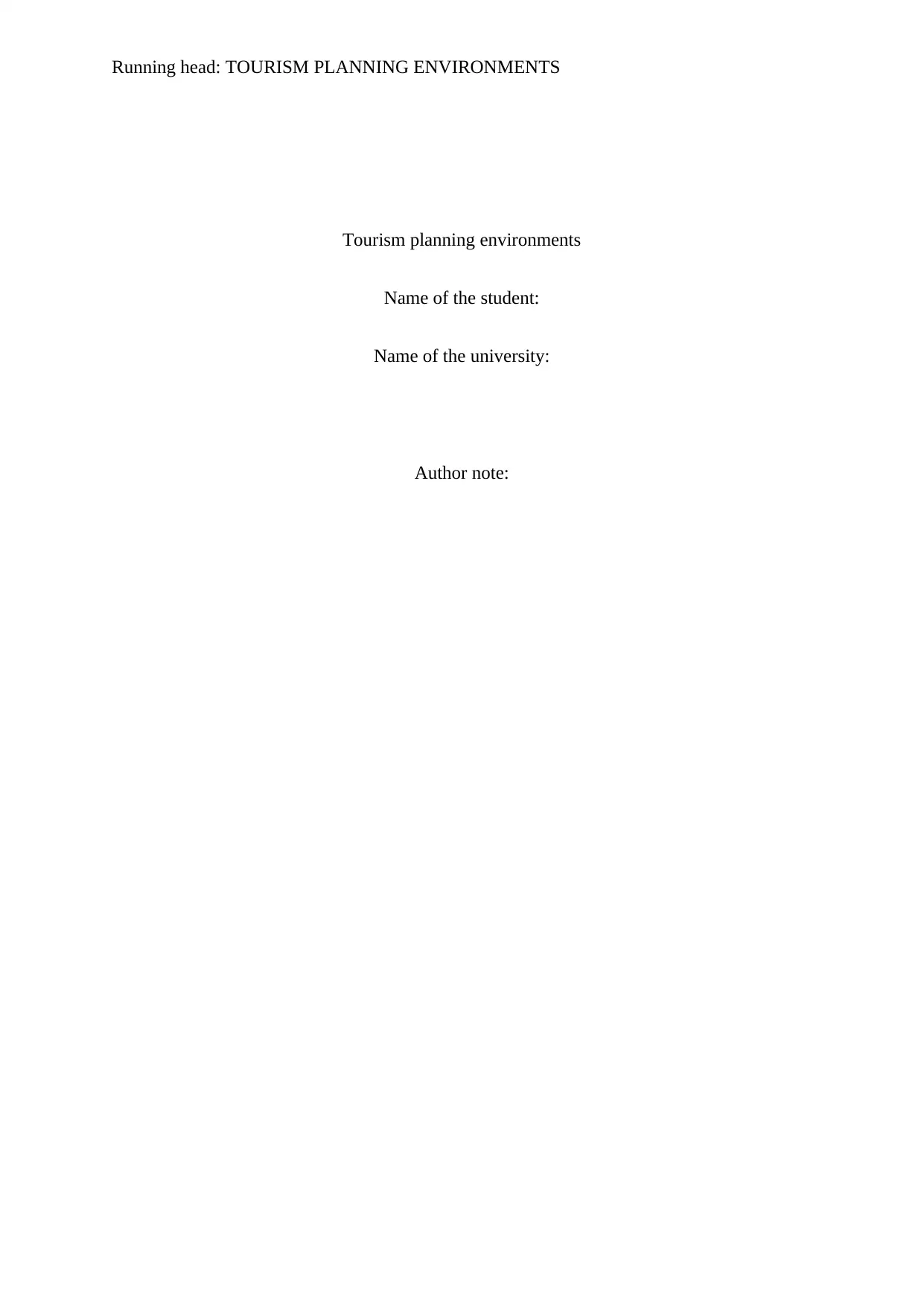
Running head: TOURISM PLANNING ENVIRONMENTS
Tourism planning environments
Name of the student:
Name of the university:
Author note:
Tourism planning environments
Name of the student:
Name of the university:
Author note:
Paraphrase This Document
Need a fresh take? Get an instant paraphrase of this document with our AI Paraphraser
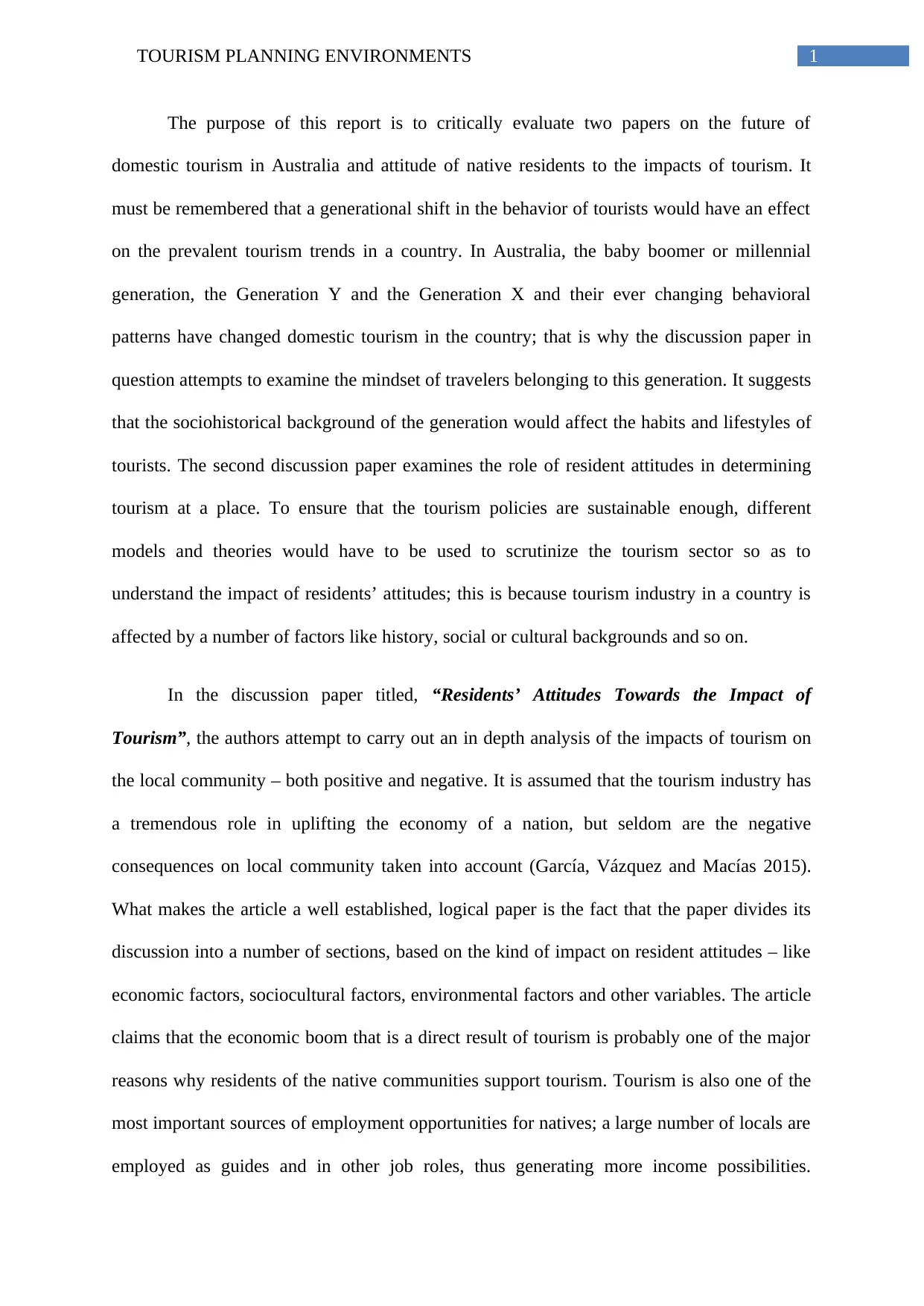
1TOURISM PLANNING ENVIRONMENTS
The purpose of this report is to critically evaluate two papers on the future of
domestic tourism in Australia and attitude of native residents to the impacts of tourism. It
must be remembered that a generational shift in the behavior of tourists would have an effect
on the prevalent tourism trends in a country. In Australia, the baby boomer or millennial
generation, the Generation Y and the Generation X and their ever changing behavioral
patterns have changed domestic tourism in the country; that is why the discussion paper in
question attempts to examine the mindset of travelers belonging to this generation. It suggests
that the sociohistorical background of the generation would affect the habits and lifestyles of
tourists. The second discussion paper examines the role of resident attitudes in determining
tourism at a place. To ensure that the tourism policies are sustainable enough, different
models and theories would have to be used to scrutinize the tourism sector so as to
understand the impact of residents’ attitudes; this is because tourism industry in a country is
affected by a number of factors like history, social or cultural backgrounds and so on.
In the discussion paper titled, “Residents’ Attitudes Towards the Impact of
Tourism”, the authors attempt to carry out an in depth analysis of the impacts of tourism on
the local community – both positive and negative. It is assumed that the tourism industry has
a tremendous role in uplifting the economy of a nation, but seldom are the negative
consequences on local community taken into account (García, Vázquez and Macías 2015).
What makes the article a well established, logical paper is the fact that the paper divides its
discussion into a number of sections, based on the kind of impact on resident attitudes – like
economic factors, sociocultural factors, environmental factors and other variables. The article
claims that the economic boom that is a direct result of tourism is probably one of the major
reasons why residents of the native communities support tourism. Tourism is also one of the
most important sources of employment opportunities for natives; a large number of locals are
employed as guides and in other job roles, thus generating more income possibilities.
The purpose of this report is to critically evaluate two papers on the future of
domestic tourism in Australia and attitude of native residents to the impacts of tourism. It
must be remembered that a generational shift in the behavior of tourists would have an effect
on the prevalent tourism trends in a country. In Australia, the baby boomer or millennial
generation, the Generation Y and the Generation X and their ever changing behavioral
patterns have changed domestic tourism in the country; that is why the discussion paper in
question attempts to examine the mindset of travelers belonging to this generation. It suggests
that the sociohistorical background of the generation would affect the habits and lifestyles of
tourists. The second discussion paper examines the role of resident attitudes in determining
tourism at a place. To ensure that the tourism policies are sustainable enough, different
models and theories would have to be used to scrutinize the tourism sector so as to
understand the impact of residents’ attitudes; this is because tourism industry in a country is
affected by a number of factors like history, social or cultural backgrounds and so on.
In the discussion paper titled, “Residents’ Attitudes Towards the Impact of
Tourism”, the authors attempt to carry out an in depth analysis of the impacts of tourism on
the local community – both positive and negative. It is assumed that the tourism industry has
a tremendous role in uplifting the economy of a nation, but seldom are the negative
consequences on local community taken into account (García, Vázquez and Macías 2015).
What makes the article a well established, logical paper is the fact that the paper divides its
discussion into a number of sections, based on the kind of impact on resident attitudes – like
economic factors, sociocultural factors, environmental factors and other variables. The article
claims that the economic boom that is a direct result of tourism is probably one of the major
reasons why residents of the native communities support tourism. Tourism is also one of the
most important sources of employment opportunities for natives; a large number of locals are
employed as guides and in other job roles, thus generating more income possibilities.
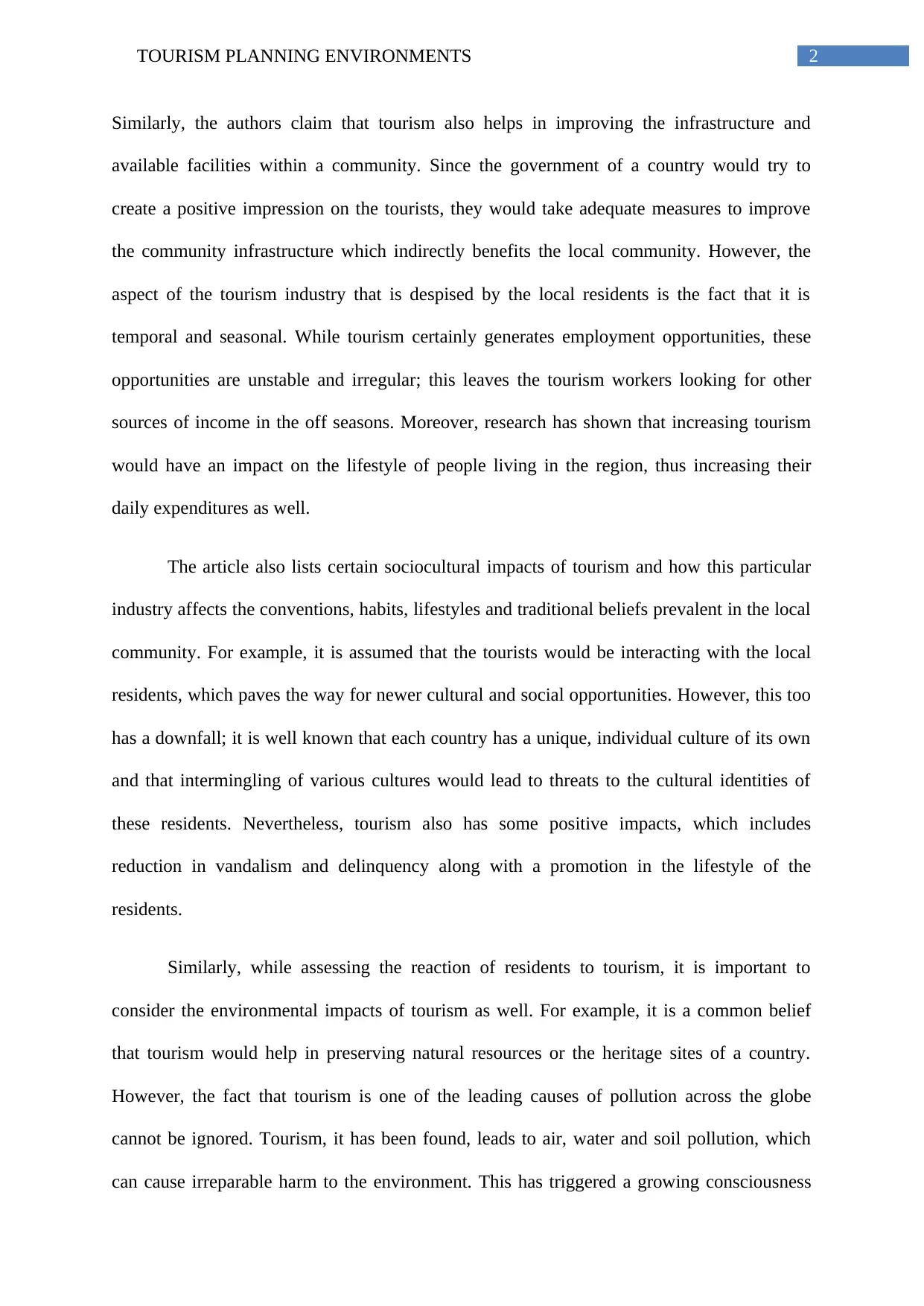
2TOURISM PLANNING ENVIRONMENTS
Similarly, the authors claim that tourism also helps in improving the infrastructure and
available facilities within a community. Since the government of a country would try to
create a positive impression on the tourists, they would take adequate measures to improve
the community infrastructure which indirectly benefits the local community. However, the
aspect of the tourism industry that is despised by the local residents is the fact that it is
temporal and seasonal. While tourism certainly generates employment opportunities, these
opportunities are unstable and irregular; this leaves the tourism workers looking for other
sources of income in the off seasons. Moreover, research has shown that increasing tourism
would have an impact on the lifestyle of people living in the region, thus increasing their
daily expenditures as well.
The article also lists certain sociocultural impacts of tourism and how this particular
industry affects the conventions, habits, lifestyles and traditional beliefs prevalent in the local
community. For example, it is assumed that the tourists would be interacting with the local
residents, which paves the way for newer cultural and social opportunities. However, this too
has a downfall; it is well known that each country has a unique, individual culture of its own
and that intermingling of various cultures would lead to threats to the cultural identities of
these residents. Nevertheless, tourism also has some positive impacts, which includes
reduction in vandalism and delinquency along with a promotion in the lifestyle of the
residents.
Similarly, while assessing the reaction of residents to tourism, it is important to
consider the environmental impacts of tourism as well. For example, it is a common belief
that tourism would help in preserving natural resources or the heritage sites of a country.
However, the fact that tourism is one of the leading causes of pollution across the globe
cannot be ignored. Tourism, it has been found, leads to air, water and soil pollution, which
can cause irreparable harm to the environment. This has triggered a growing consciousness
Similarly, the authors claim that tourism also helps in improving the infrastructure and
available facilities within a community. Since the government of a country would try to
create a positive impression on the tourists, they would take adequate measures to improve
the community infrastructure which indirectly benefits the local community. However, the
aspect of the tourism industry that is despised by the local residents is the fact that it is
temporal and seasonal. While tourism certainly generates employment opportunities, these
opportunities are unstable and irregular; this leaves the tourism workers looking for other
sources of income in the off seasons. Moreover, research has shown that increasing tourism
would have an impact on the lifestyle of people living in the region, thus increasing their
daily expenditures as well.
The article also lists certain sociocultural impacts of tourism and how this particular
industry affects the conventions, habits, lifestyles and traditional beliefs prevalent in the local
community. For example, it is assumed that the tourists would be interacting with the local
residents, which paves the way for newer cultural and social opportunities. However, this too
has a downfall; it is well known that each country has a unique, individual culture of its own
and that intermingling of various cultures would lead to threats to the cultural identities of
these residents. Nevertheless, tourism also has some positive impacts, which includes
reduction in vandalism and delinquency along with a promotion in the lifestyle of the
residents.
Similarly, while assessing the reaction of residents to tourism, it is important to
consider the environmental impacts of tourism as well. For example, it is a common belief
that tourism would help in preserving natural resources or the heritage sites of a country.
However, the fact that tourism is one of the leading causes of pollution across the globe
cannot be ignored. Tourism, it has been found, leads to air, water and soil pollution, which
can cause irreparable harm to the environment. This has triggered a growing consciousness
⊘ This is a preview!⊘
Do you want full access?
Subscribe today to unlock all pages.

Trusted by 1+ million students worldwide
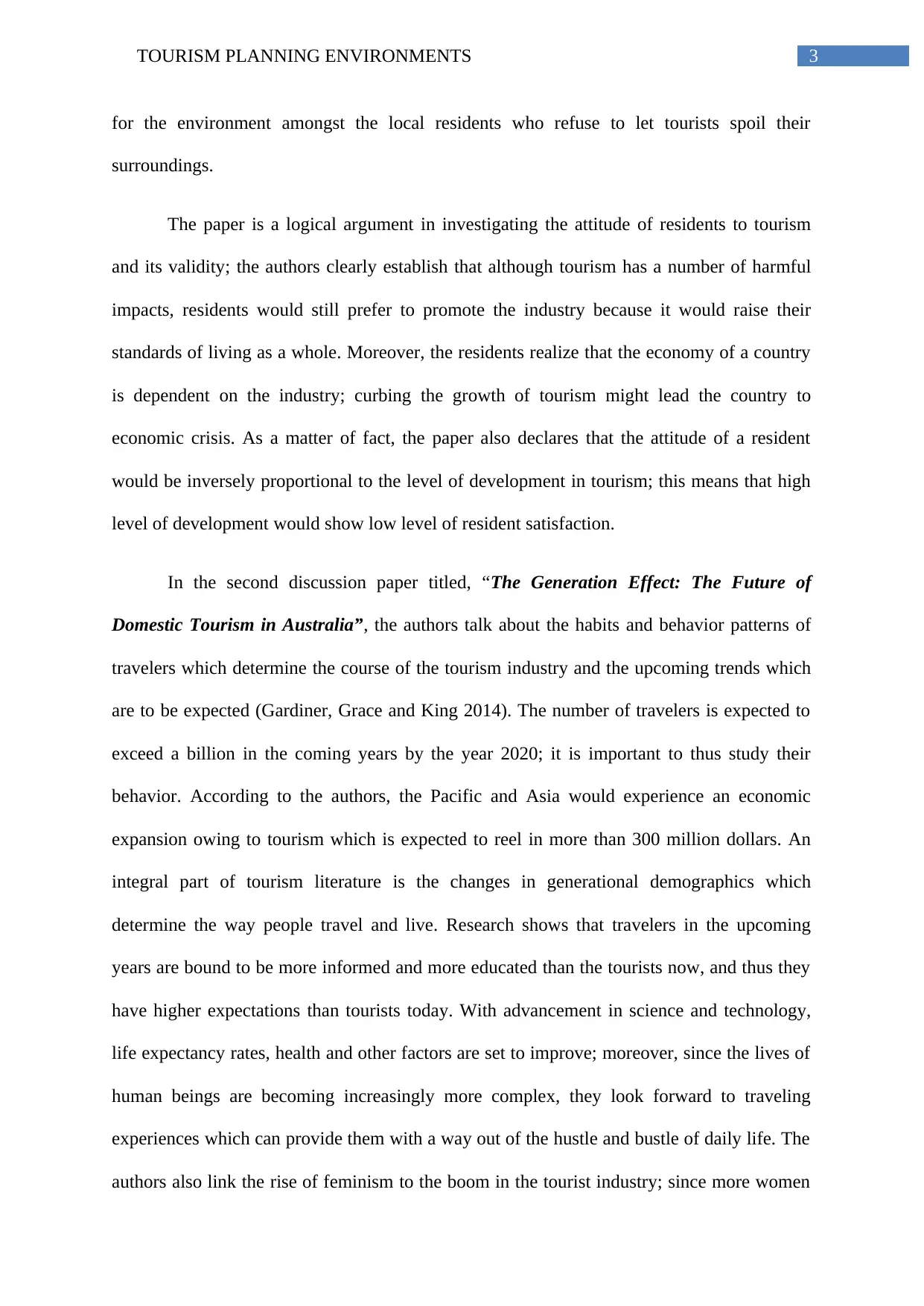
3TOURISM PLANNING ENVIRONMENTS
for the environment amongst the local residents who refuse to let tourists spoil their
surroundings.
The paper is a logical argument in investigating the attitude of residents to tourism
and its validity; the authors clearly establish that although tourism has a number of harmful
impacts, residents would still prefer to promote the industry because it would raise their
standards of living as a whole. Moreover, the residents realize that the economy of a country
is dependent on the industry; curbing the growth of tourism might lead the country to
economic crisis. As a matter of fact, the paper also declares that the attitude of a resident
would be inversely proportional to the level of development in tourism; this means that high
level of development would show low level of resident satisfaction.
In the second discussion paper titled, “The Generation Effect: The Future of
Domestic Tourism in Australia”, the authors talk about the habits and behavior patterns of
travelers which determine the course of the tourism industry and the upcoming trends which
are to be expected (Gardiner, Grace and King 2014). The number of travelers is expected to
exceed a billion in the coming years by the year 2020; it is important to thus study their
behavior. According to the authors, the Pacific and Asia would experience an economic
expansion owing to tourism which is expected to reel in more than 300 million dollars. An
integral part of tourism literature is the changes in generational demographics which
determine the way people travel and live. Research shows that travelers in the upcoming
years are bound to be more informed and more educated than the tourists now, and thus they
have higher expectations than tourists today. With advancement in science and technology,
life expectancy rates, health and other factors are set to improve; moreover, since the lives of
human beings are becoming increasingly more complex, they look forward to traveling
experiences which can provide them with a way out of the hustle and bustle of daily life. The
authors also link the rise of feminism to the boom in the tourist industry; since more women
for the environment amongst the local residents who refuse to let tourists spoil their
surroundings.
The paper is a logical argument in investigating the attitude of residents to tourism
and its validity; the authors clearly establish that although tourism has a number of harmful
impacts, residents would still prefer to promote the industry because it would raise their
standards of living as a whole. Moreover, the residents realize that the economy of a country
is dependent on the industry; curbing the growth of tourism might lead the country to
economic crisis. As a matter of fact, the paper also declares that the attitude of a resident
would be inversely proportional to the level of development in tourism; this means that high
level of development would show low level of resident satisfaction.
In the second discussion paper titled, “The Generation Effect: The Future of
Domestic Tourism in Australia”, the authors talk about the habits and behavior patterns of
travelers which determine the course of the tourism industry and the upcoming trends which
are to be expected (Gardiner, Grace and King 2014). The number of travelers is expected to
exceed a billion in the coming years by the year 2020; it is important to thus study their
behavior. According to the authors, the Pacific and Asia would experience an economic
expansion owing to tourism which is expected to reel in more than 300 million dollars. An
integral part of tourism literature is the changes in generational demographics which
determine the way people travel and live. Research shows that travelers in the upcoming
years are bound to be more informed and more educated than the tourists now, and thus they
have higher expectations than tourists today. With advancement in science and technology,
life expectancy rates, health and other factors are set to improve; moreover, since the lives of
human beings are becoming increasingly more complex, they look forward to traveling
experiences which can provide them with a way out of the hustle and bustle of daily life. The
authors also link the rise of feminism to the boom in the tourist industry; since more women
Paraphrase This Document
Need a fresh take? Get an instant paraphrase of this document with our AI Paraphraser
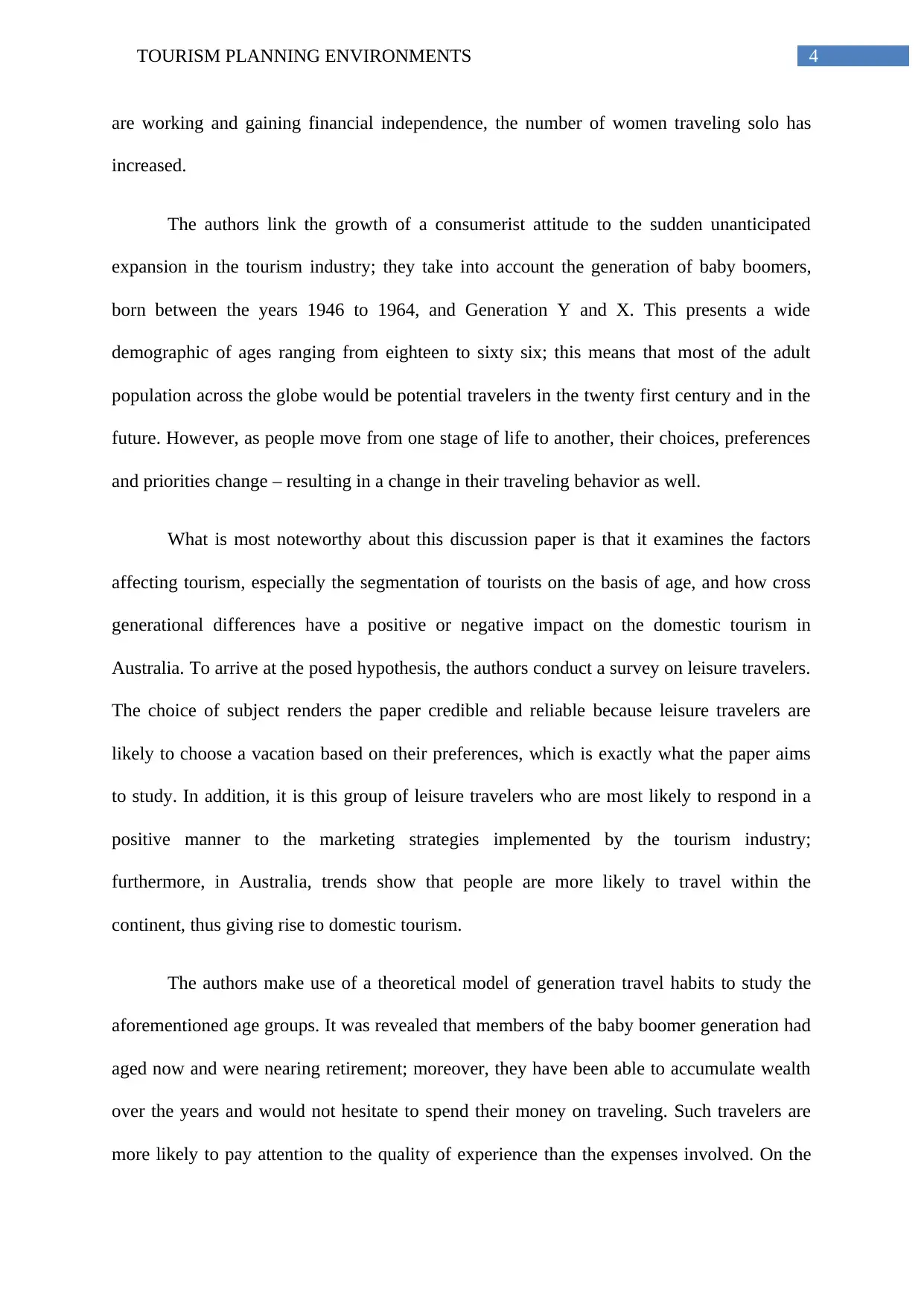
4TOURISM PLANNING ENVIRONMENTS
are working and gaining financial independence, the number of women traveling solo has
increased.
The authors link the growth of a consumerist attitude to the sudden unanticipated
expansion in the tourism industry; they take into account the generation of baby boomers,
born between the years 1946 to 1964, and Generation Y and X. This presents a wide
demographic of ages ranging from eighteen to sixty six; this means that most of the adult
population across the globe would be potential travelers in the twenty first century and in the
future. However, as people move from one stage of life to another, their choices, preferences
and priorities change – resulting in a change in their traveling behavior as well.
What is most noteworthy about this discussion paper is that it examines the factors
affecting tourism, especially the segmentation of tourists on the basis of age, and how cross
generational differences have a positive or negative impact on the domestic tourism in
Australia. To arrive at the posed hypothesis, the authors conduct a survey on leisure travelers.
The choice of subject renders the paper credible and reliable because leisure travelers are
likely to choose a vacation based on their preferences, which is exactly what the paper aims
to study. In addition, it is this group of leisure travelers who are most likely to respond in a
positive manner to the marketing strategies implemented by the tourism industry;
furthermore, in Australia, trends show that people are more likely to travel within the
continent, thus giving rise to domestic tourism.
The authors make use of a theoretical model of generation travel habits to study the
aforementioned age groups. It was revealed that members of the baby boomer generation had
aged now and were nearing retirement; moreover, they have been able to accumulate wealth
over the years and would not hesitate to spend their money on traveling. Such travelers are
more likely to pay attention to the quality of experience than the expenses involved. On the
are working and gaining financial independence, the number of women traveling solo has
increased.
The authors link the growth of a consumerist attitude to the sudden unanticipated
expansion in the tourism industry; they take into account the generation of baby boomers,
born between the years 1946 to 1964, and Generation Y and X. This presents a wide
demographic of ages ranging from eighteen to sixty six; this means that most of the adult
population across the globe would be potential travelers in the twenty first century and in the
future. However, as people move from one stage of life to another, their choices, preferences
and priorities change – resulting in a change in their traveling behavior as well.
What is most noteworthy about this discussion paper is that it examines the factors
affecting tourism, especially the segmentation of tourists on the basis of age, and how cross
generational differences have a positive or negative impact on the domestic tourism in
Australia. To arrive at the posed hypothesis, the authors conduct a survey on leisure travelers.
The choice of subject renders the paper credible and reliable because leisure travelers are
likely to choose a vacation based on their preferences, which is exactly what the paper aims
to study. In addition, it is this group of leisure travelers who are most likely to respond in a
positive manner to the marketing strategies implemented by the tourism industry;
furthermore, in Australia, trends show that people are more likely to travel within the
continent, thus giving rise to domestic tourism.
The authors make use of a theoretical model of generation travel habits to study the
aforementioned age groups. It was revealed that members of the baby boomer generation had
aged now and were nearing retirement; moreover, they have been able to accumulate wealth
over the years and would not hesitate to spend their money on traveling. Such travelers are
more likely to pay attention to the quality of experience than the expenses involved. On the
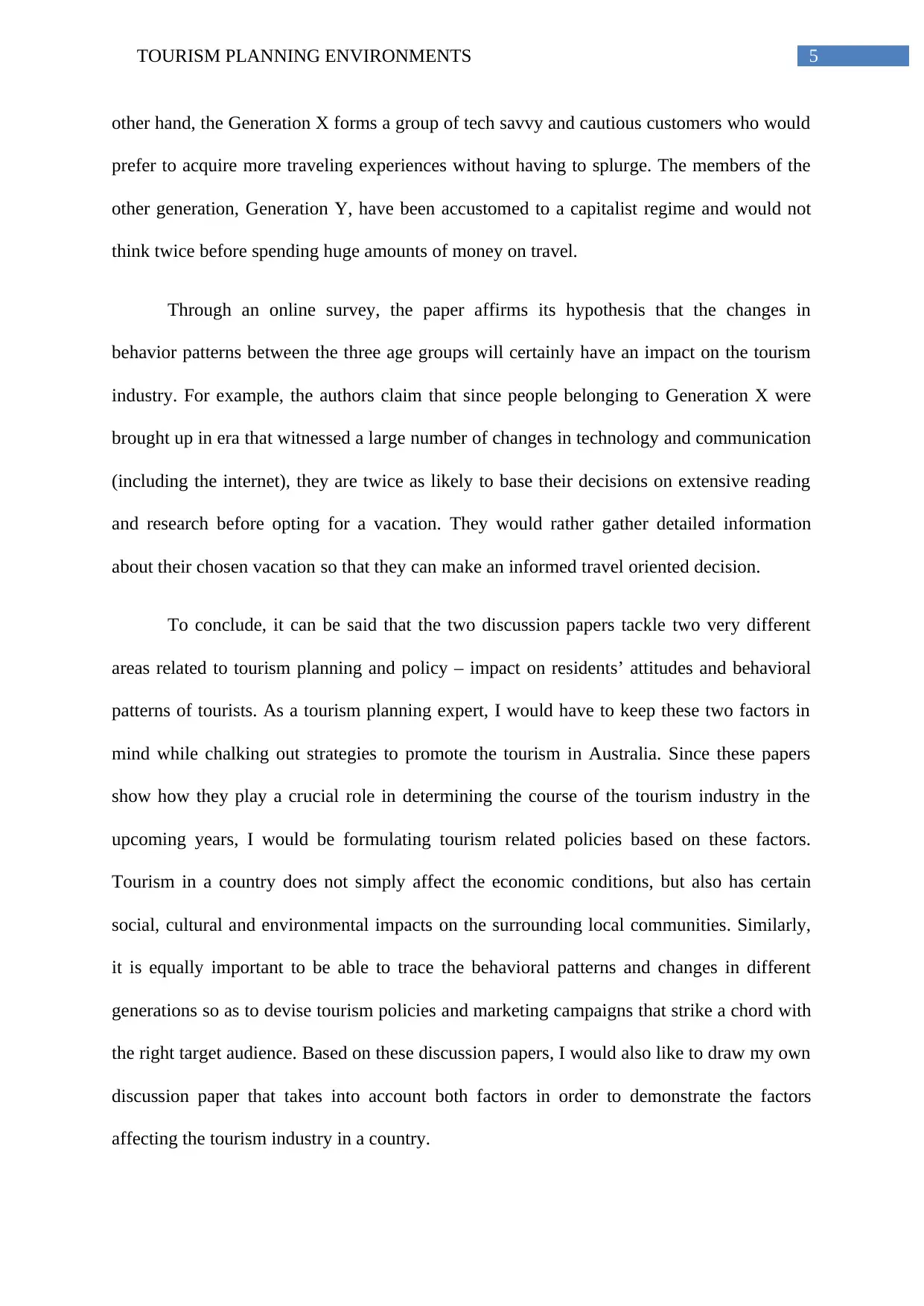
5TOURISM PLANNING ENVIRONMENTS
other hand, the Generation X forms a group of tech savvy and cautious customers who would
prefer to acquire more traveling experiences without having to splurge. The members of the
other generation, Generation Y, have been accustomed to a capitalist regime and would not
think twice before spending huge amounts of money on travel.
Through an online survey, the paper affirms its hypothesis that the changes in
behavior patterns between the three age groups will certainly have an impact on the tourism
industry. For example, the authors claim that since people belonging to Generation X were
brought up in era that witnessed a large number of changes in technology and communication
(including the internet), they are twice as likely to base their decisions on extensive reading
and research before opting for a vacation. They would rather gather detailed information
about their chosen vacation so that they can make an informed travel oriented decision.
To conclude, it can be said that the two discussion papers tackle two very different
areas related to tourism planning and policy – impact on residents’ attitudes and behavioral
patterns of tourists. As a tourism planning expert, I would have to keep these two factors in
mind while chalking out strategies to promote the tourism in Australia. Since these papers
show how they play a crucial role in determining the course of the tourism industry in the
upcoming years, I would be formulating tourism related policies based on these factors.
Tourism in a country does not simply affect the economic conditions, but also has certain
social, cultural and environmental impacts on the surrounding local communities. Similarly,
it is equally important to be able to trace the behavioral patterns and changes in different
generations so as to devise tourism policies and marketing campaigns that strike a chord with
the right target audience. Based on these discussion papers, I would also like to draw my own
discussion paper that takes into account both factors in order to demonstrate the factors
affecting the tourism industry in a country.
other hand, the Generation X forms a group of tech savvy and cautious customers who would
prefer to acquire more traveling experiences without having to splurge. The members of the
other generation, Generation Y, have been accustomed to a capitalist regime and would not
think twice before spending huge amounts of money on travel.
Through an online survey, the paper affirms its hypothesis that the changes in
behavior patterns between the three age groups will certainly have an impact on the tourism
industry. For example, the authors claim that since people belonging to Generation X were
brought up in era that witnessed a large number of changes in technology and communication
(including the internet), they are twice as likely to base their decisions on extensive reading
and research before opting for a vacation. They would rather gather detailed information
about their chosen vacation so that they can make an informed travel oriented decision.
To conclude, it can be said that the two discussion papers tackle two very different
areas related to tourism planning and policy – impact on residents’ attitudes and behavioral
patterns of tourists. As a tourism planning expert, I would have to keep these two factors in
mind while chalking out strategies to promote the tourism in Australia. Since these papers
show how they play a crucial role in determining the course of the tourism industry in the
upcoming years, I would be formulating tourism related policies based on these factors.
Tourism in a country does not simply affect the economic conditions, but also has certain
social, cultural and environmental impacts on the surrounding local communities. Similarly,
it is equally important to be able to trace the behavioral patterns and changes in different
generations so as to devise tourism policies and marketing campaigns that strike a chord with
the right target audience. Based on these discussion papers, I would also like to draw my own
discussion paper that takes into account both factors in order to demonstrate the factors
affecting the tourism industry in a country.
⊘ This is a preview!⊘
Do you want full access?
Subscribe today to unlock all pages.

Trusted by 1+ million students worldwide
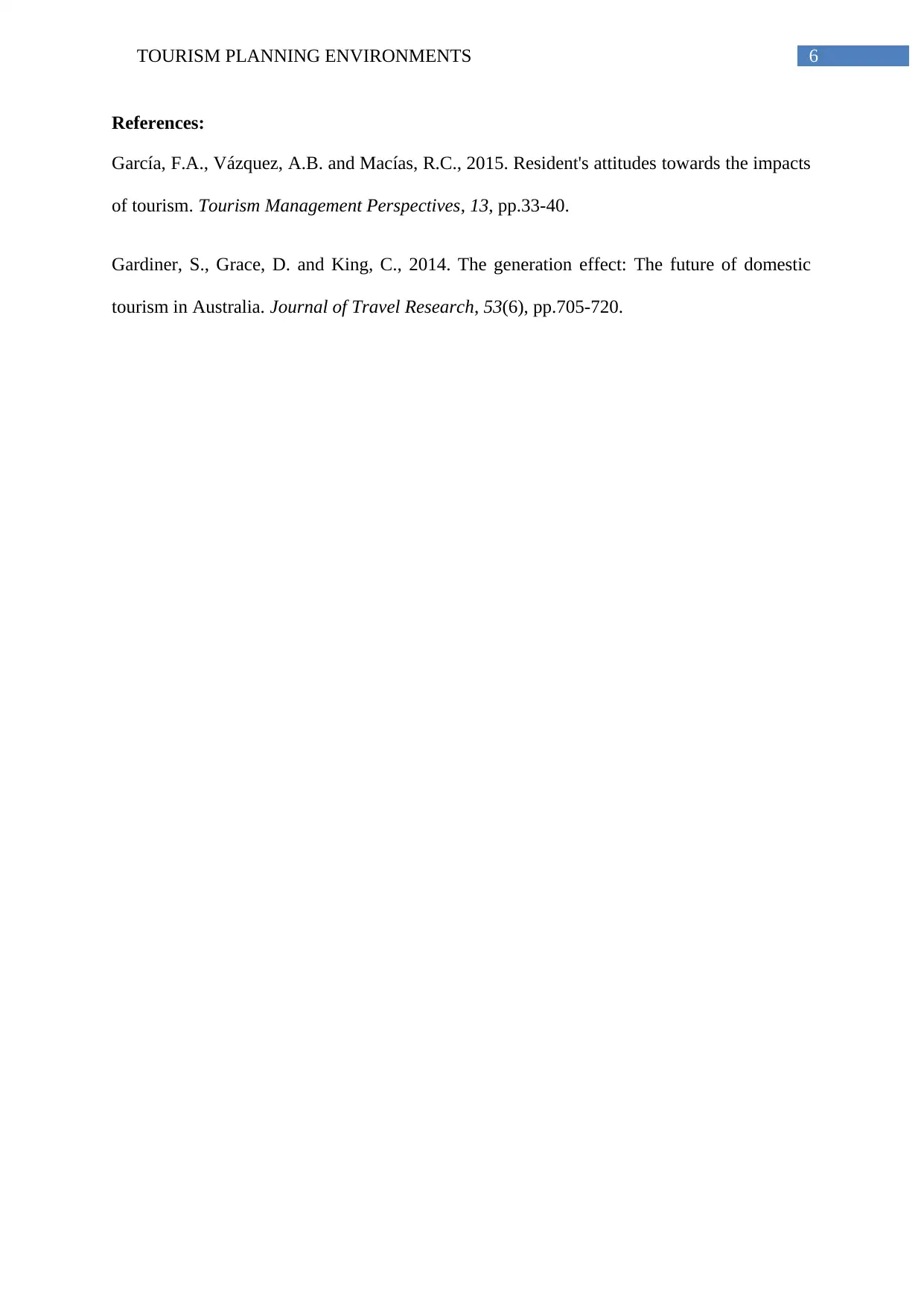
6TOURISM PLANNING ENVIRONMENTS
References:
García, F.A., Vázquez, A.B. and Macías, R.C., 2015. Resident's attitudes towards the impacts
of tourism. Tourism Management Perspectives, 13, pp.33-40.
Gardiner, S., Grace, D. and King, C., 2014. The generation effect: The future of domestic
tourism in Australia. Journal of Travel Research, 53(6), pp.705-720.
References:
García, F.A., Vázquez, A.B. and Macías, R.C., 2015. Resident's attitudes towards the impacts
of tourism. Tourism Management Perspectives, 13, pp.33-40.
Gardiner, S., Grace, D. and King, C., 2014. The generation effect: The future of domestic
tourism in Australia. Journal of Travel Research, 53(6), pp.705-720.
1 out of 7
Related Documents
Your All-in-One AI-Powered Toolkit for Academic Success.
+13062052269
info@desklib.com
Available 24*7 on WhatsApp / Email
![[object Object]](/_next/static/media/star-bottom.7253800d.svg)
Unlock your academic potential
Copyright © 2020–2025 A2Z Services. All Rights Reserved. Developed and managed by ZUCOL.



